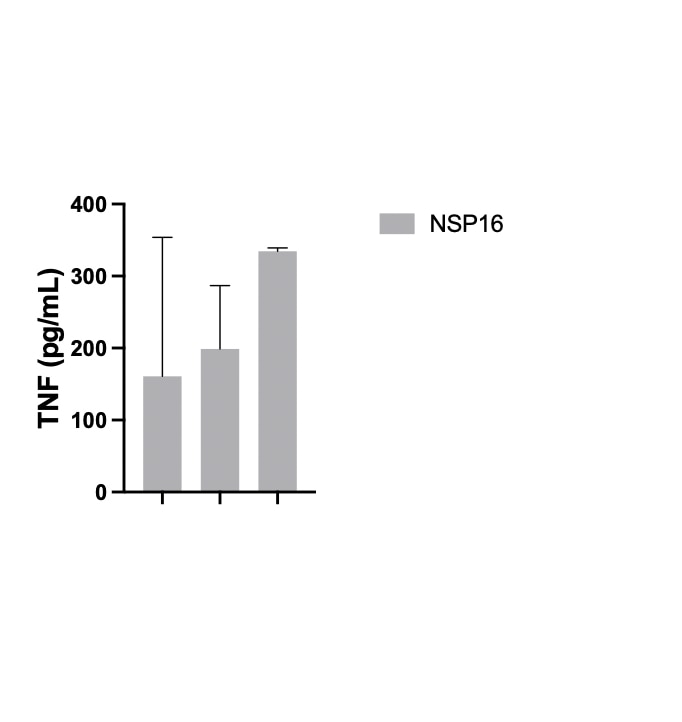Recombinant SARS-CoV-2 NSP16/NSP10-His Complex, CF Summary
Product Specifications
| SARS-CoV-2 NSP16 (Ser1-Asn298) Accession # YP_009725311.1 | |
| SARS-CoV-2 NSP10 (Ala1-Gln139) Accession # YP_009725306.1 | 6-His tag |
| N-terminus | C-terminus |
Analysis
Product Datasheets
Carrier Free
CF stands for Carrier Free (CF). We typically add Bovine Serum Albumin (BSA) as a carrier protein to our recombinant proteins. Adding a carrier protein enhances protein stability, increases shelf-life, and allows the recombinant protein to be stored at a more dilute concentration. The carrier free version does not contain BSA.
In general, we advise purchasing the recombinant protein with BSA for use in cell or tissue culture, or as an ELISA standard. In contrast, the carrier free protein is recommended for applications, in which the presence of BSA could interfere.
10634-CV
| Formulation | Supplied as a 0.2 μm filtered solution in Tris, NaCl, TCEP and Glycerol. |
| Shipping | The product is shipped with polar packs. Upon receipt, store it immediately at the temperature recommended below. |
| Stability & Storage: | Use a manual defrost freezer and avoid repeated freeze-thaw cycles.
|
Scientific Data
 View Larger
View Larger
2 μg/lane of Recombinant SARS-CoV-2 NSP16/NSP10-His Complex (Catalog # 10634-CV) was resolved with SDS-PAGE under reducing (R) and non-reducing (NR) conditions and visualized by Coomassie® Blue staining, showing bands at 34 kDa and 17 kDa under reducing conditions.
Reconstitution Calculator
Background: NSP16/NSP10
Non-structural protein 16 (NSP16) and NSP10 are two of several functional proteins released by ORF1a-encoded protease cleavage of the pp1a and pp1ab replicase polyproteins expressed from the coronavirus (CoV) genome (1). The NSPs are involved in the replication and transcription of the viral RNA and not incorporated within the virion particles. Coronaviruses include various highly pathogenic strains such as SARS-CoV, MERS-CoV and SARS-CoV2 that have had significant impact on humans as well as strains that have negatively impacted livestock. NSP16 is a small monomeric 298 amino acid protein with a characteristic fold of the class I methyltransferase (MTase) family with a seven-stranded B-sheet surrounded by alpha-helices and loops that bind the cap and form a cap-binding groove and S-adenosylmethionine (SAM) cleft (2,3). NSP10 is a small 139 amino acid protein capable of forming independent dodecameric structures composed of four identical trimers where each monomer is capable of binding two zinc ions (4,5). Both the NSP16 and NSP10 SARS-CoV2 sequences are highly conserved across coronaviruses (3). NSP16 catalyzes 2'-O-MTase activity specifically on capped N7-methylated RNA through methylation of the 2'-hydroxy group of adenine using SAM as a methyl donor (6). The viral RNA cap structure protects it from degradation, promotes mRNA translation, and prevents the viral RNA from being recognized by innate immune mechanisms (7). NSP16 was shown to interact strongly with NSP10 (8) in a monomeric form via hydrophic interactions and hydrogen bonds in the interface (3). The MTase activity of NSP16 requires interaction with NSP10 (2,7). NSP10 interaction extends and narrows the RNA-binding groove that accommodates the substrate and stabilizes NSP16 (2,3,9). The dimerization interface between NSP16 and NSP10 is critical and can be used as a target to effectively reduce replication and pathogenesis (10,11).
- Snijder, E.J. et al. (2016) Adv. Virus Res 96:59.
- Chen, Y. et al. (2011) PLoS Pathog. 7:e1002294.
- Rosas-Lemus, M. et al. (2020) bioRxiv In press.
- Matthes, N. et al. (2006) FEBS Lett. 580:4143.
- Su, D. et al. (2006) J. Virol. 80:7902.
- Bouvet, M. et al. (2012) Proc. Natl. Acad. Sci. U.S.A. 109:9372.
- Decroly, E. et al. (2011) PLoS Pathog. 7:e1002059.
- Pan, J. et al. (2008) PLoS One 3:e3299.
- Bouvet, M. et al. (2014) J. Biol. Chem. 289:25783.
- Ma, Y. et al. (2015) Proc. Natl. Acad. Sci. 112:9436.
- Wang, Y. et al. (2015) J. Virol 89:8416.
FAQs
No product specific FAQs exist for this product, however you may
View all Proteins and Enzyme FAQsReviews for Recombinant SARS-CoV-2 NSP16/NSP10-His Complex, CF
Average Rating: 4 (Based on 1 Review)
Have you used Recombinant SARS-CoV-2 NSP16/NSP10-His Complex, CF?
Submit a review and receive an Amazon gift card.
$25/€18/£15/$25CAN/¥75 Yuan/¥2500 Yen for a review with an image
$10/€7/£6/$10 CAD/¥70 Yuan/¥1110 Yen for a review without an image
Filter by:

